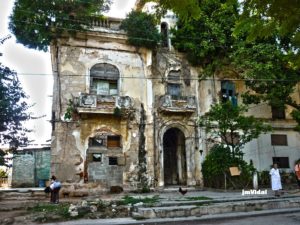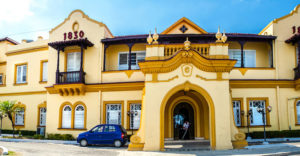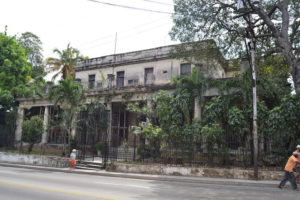“El Cerro has the key,” is the title of a guaracha that composed Fernando Noa in 1949 and musicalized and popularized Arsenio Rodríguez.
Now you have to see where the expression comes from. And is that the first aqueduct built by the Spaniards in America, back in 1592, the so-called Zanja Real, crossed the town of El Cerro. After that the Aqueduct of Fernando VII in 1835 also crossed that neighborhood and later the Aqueduct of Albear in 1893, that has its deposits in Palatino, that is part of the Hill. It means that the water of Havana for centuries, has been distributed through El Cerro, and so has the key. The water key, which is a very important key.
The patio of my house was right on “El Canal del Cerro” with a pipeline and gravity system that still works. And talking about El Canal del Cerro was talking about an extreme marginal neighborhood, where anything could happen. As a kid I was very surprised that the place was characters such as actor Otto Sirgo, and singers Orlando Contreras and Benny Moré. Surely they were great consumers of the plantations that existed there because neither the police ventured to enter. Right on Calle Salvador, at the intersection with the Canal, there was a cellar of death that was not known how it survived because it did not sell anything, but it had an almost empty window with a soap, a cheap perfume and I do not know what else to look like its sale, when in fact it was a place to aim the “ball” game prohibited, but not prohibited by the police who were often to charge their commission.
We lived in a sumptuous wooden house, walls and roof built in the early twentieth century with portal and gigantic patios, a basement throughout the house and in an environment where workers, masons, cobblers, plumbers , carpenters and service workers, and others who lived in santeria or marihuana traffic, with lots of lots or neighborhood houses (until then I did not know that people lived in such terrible conditions) and was located very close to the Palatino and Buenos Aires, with the colossal producer of beers and malts Tívoli, (already already in decline for the new factories built), the New Ice Factory Company, Crusellas, a major producer of soaps and detergents and other products of cleaning and grooming, La Estrella and Ambrosía large producers of chocolates and preserves, the then very popular Menem perfumery products, the Coca Cola factory and Canada Dry, Mat herb and salutaris and other industries. In addition there are the Cerro Stadium, the largest baseball stadium in the country and the Sports City. The Cerro was originally an aristocratic territory, and then transmuted into the most marginal of neighborhoods.
This neighborhood, whose impressive splendor and rapid decay occurred within the nineteenth century, was the main exponent of Cuban neoclassical architecture. No other important city in Latin America produced or could preserve an urban axis so relevant and coherent. The history of Cerro was associated with the birth of the national identity in the Creole oligarchy, a process that was essentially Habanero. The Cerro conserves a unique and very valuable architectural heritage, in spite of the advanced deterioration.
But on the other hand in that neighborhood have arisen artists and intellectuals who have transcended the borders not of the neighborhood nor of the country but of the world. Portocarrero met the painting there, born in Calzada del Cerro and a remarkable series of his paintings is called “Interiors of the Cerro”. Reneé Méndez Capote, the great writer, put her memories in “Nostalgias of a Havana of the Hill”. Also from there is Jose Delarra, a sculptor known for his works in Cuba and abroad. Alberto Díaz Gutiérrez, better known as Alberto Korda, a Cuban photographer of world fame is another of his famous. José Tejedor was a composer, guitarist and singer of bolero, blind, walked the streets of his neighborhood in suit and tie. Eligio Sardiñas Montalvo, Kid Chocolate, was born in the municipality of the Cerro Habanero. He appears on the select list of boxing immortals and his statue boasts one of the entrances to the famed Madison Square Garden in New York.
The Cerro was a popular neighborhood of the least favored but that counted on the Colossus, Mexico, the Valentino, the Principal, the Edison and the Maravillas, six cinemas that were always filled full even though there was a large population interested in another type of art, as was the comparsa of Alacrán.
But Cerro today is another thing, it is one of the poorest neighborhoods economically and the most traditional and rich when we speak of manifestations of popular culture. It is a place where privacy is impossible, where the music equipment is blaring everywhere and the shouting replaces the conversation. And if El Cerro has the key, he has it hidden, because there are many years that there are problems with water in Havana.
LA HABANA, “EL CERRO TIENE LA LLAVE”. PERSONAJES Y CHISMES.
“El Cerro tiene la llave”, es el título de una guaracha que compuso Fernando Noa en 1949 y musicalizó y popularizó Arsenio Rodríguez.
Ahora hay que ver de dónde viene la expresión. Y es que el primer acueducto construido por los españoles en América, por allá por 1592, la llamada Zanja Real, atravesaba la localidad de El Cerro. Después de ello el Acueducto de Fernando VII en 1835 también atravesó ese barrio y más tarde el Acueducto de Albear en 1893, que tiene sus depósitos en Palatino, que es parte de el Cerro. Quiere decir que el agua de La Habana durantes siglos, se ha distribuido a través de El Cerro, y por eso tiene la llave. La llave del agua, que es una llave importantísima.
El patio de mi casa daba justamente a “El Canal del Cerro” con un sistema de abasto por cañerías y gravedad que todavía funciona. Y hablar de El Canal del Cerro era hablar de un barrio marginal extremo, donde podía ocurrir cualquier cosa. Cuando niño me extrañaba mucho que a ese lugar fueran personajes como el actor Otto Sirgo, y los cantantes Orlando Contreras y Benny Moré. Seguramente eran grandes consumidores de las plantaciones que allí existían porque ni la policía se aventuraban a entrar. Justo en la calle Salvador, en la intersección con el Canal, existía una bodega de mala muerte que no se sabía cómo sobrevivía porque no vendía nada,, pero tenía una vidriera casi vacía con un jabón, un perfume barato y no se que otra cosa para aparentar su venta, cuando en realidad era un lugar para apuntar la “bolita” juego prohibido, pero no prohibido por los policías que iban a menudo a cobrar su comisión.
Vivíamos en una suntuosa casa de piso, paredes y techo de madera construida a principios del siglo XX con portal y patios gigantescos, un sótano a lo largo y ancho de toda la casa y en un entorno donde predominaban los obreros, albañiles, zapateros, plomeros, carpinteros y trabajadores de servicios y otros que vivían de la santería o del tráfico de marihuana, con gran cantidad de solares o casas de vecindad, (hasta entonces no sabía que la gente vivía en esas pésimas condiciones) y estaba situada muy cerca de los nudos fabriles de Palatino y Buenos Aires, con la colosal productora de cervezas y maltas Tívoli, (ya entonces en declive por las nuevas fábricas construidas), de la Compañía Nueva Fábrica de Hielo, Crusellas, gran productor de jabones y detergentes y otros productos de limpieza y aseo, La Estrella y la Ambrosía grandes productores de chocolates y confituras, los entonces muy populares productos de perfumería Menem, la fábrica de Coca Cola y de Canada Dry, Materva y Salutaris y otras industrias. Además allí están el estadio del Cerro, el mayor estadio beisbolero del país y la Ciudad Deportiva. El Cerro fue originalmente un territorio aristocrático, y luego transmutado en el más marginal de los barrios.
Este barrio,cuyo impresionante esplendor y rápida decadencia ocurrió dentro del siglo XIX, fue el principal exponente de la arquitectura neoclásica cubana.Ninguna otra ciudad importante de América Latina produjo o pudo conservar un eje urbano tan relevante y coherente. La historia del Cerro estuvo asociada con el nacimiento de la identidad nacional en la oligarquía criolla, un proceso que fue en esencia habanero. El Cerro conserva un patrimonio arquitectónico único y muy valioso, a pesar del avanzado deterioro.
Pero por otra parte en ese barrio han surgido artistas e intelectuales que han trascendido las fronteras no del barrio ni del país sino del mundo. Portocarrero conoció allí la pintura, había nacido en Calzada del Cerro y una serie notable de sus pinturas se llama “Interiores delCerro”. Reneé Méndez Capote, la insigne escritora, plasmó sus memorias en “Nostalgias de una habanera de el Cerro”. También es de allí José Delarra, escultor conocido por sus obras en Cuba y en el extranjero. Alberto Díaz Gutiérrez, más conocido como Alberto Korda, fotógrafo cubano de fama mundial es otro de sus famosos. José Tejedor fue un compositor, guitarrista y cantante de bolero, ciego, se paseaba por las calles de su barrio de traje y corbata. Eligio Sardiñas Montalvo, Kid Chocolate, nace en el municipio habanero del Cerro. Aparece en la selecta lista de los inmortales del boxeo y su estatua prestigia una de las entradas del afamado Madison Square Garden, en Nueva York.
El cerro era un barrio popular de los menos favorecidos pero que contaba con el Coloso, el México, el Valentino, el Principal, el Edison y el Maravillas, seis cines que siempre estaban a lleno completo a pesar de que había una gran población interesada en otro tipo de arte, como era la comparsa del Alacrán.
Pero el Cerro de hoy en día es otra cosa, es uno de las barrios más pobres económicamente y de los más tradicionales y rico cuando hablamos de manifestaciones de la cultura popular. Es un lugar donde la privacidad es imposible, donde los equipos de música están a todo volumen en todas partes y la gritería sustituye a la conversación. Y si El Cerro tiene la llave, la tiene escondida, porque hace muchísimos años que hay problemas con el agua en La Habana.
Agencies/MemoriasCubanas/Carlos Rodríguez/Extractos/Internet Photos/Arnoldo Varona/TheCubanHistory.com
THE CUBAN HISTORY, HOLLYWOOD.










